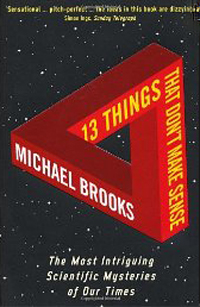Being completely and utterly stuck can be a good thing

13 Things That Don’t Make Sense: the Most Intriguing Scientific Mysteries of Our Time
by Michael Brooks
This is my second read in my 2014 Popular-Science Reading Challenge. It deals with quite a disparate range of areas of science. I enjoyed reading it but little of the science has stayed with me.
To be fair, while reading it I was impressed by how well it explained some areas of science I had previously found hard to grasp, such as redshift. And I enjoyed interesting random titbits with Tim. But I did have reservations as well.
“I like to think of scientists as on top of things, able to explain the world we live in, masters of their universe. But maybe that’s just a comforting delusion…In science, being completely and utterly stuck can be a good thing; it often means a revolution is coming.”
The scientific mysteries covered range from ones I already knew something about, such as dark matter and free will, to ones I hadn’t heard of, or didn’t know were mysteries – a freaky giant virus that redefined what we consider to be “alive”, or the Pioneer anomaly.
What the chapters actually contain is also very varied. Some are very linear, following the story of one fairly specific topic from start to controversy to present, such as cold fusion (which is one of those things I’d heard of but didn’t realise had some basis in reality). Others are much wider ranging, taking massive topics – life, death and sex – and explaining in what way they are scientific mysteries. For instance, is life just the result of chemical reactions? The very simplest forms of life may be no more than that, but complex life has so far defied chemical explanation.
“Why do living things die? Obviously, things kill each other – that’s part of the natural order. But what causes ‘natural’ death? It is a question that splits biologists. It has become like a game of ping-pong; over the years, theories have been batted back and forth [but] none of the theories fit all of the available evidence.”
One other tack that Brooks takes is to start with a relatively small scientific anomaly that gives food for big discussion. For instance, the Wow! signal leads to explaining the SETI project and from there the prospects for alien life. Actually that’s one chapter I found a bit disappointing, perhaps because I don’t think I learned anything new from it.
But my main reservation is how often Brooks takes the side of the “underdog”, defending many scientific topics – and indeed scientists – that have been widely maligned. While I accept that it’s good journalism – and more interesting for the reader – to present both sides of the story, I can’t help thinking there’s probably good reason these are considered fringe topics. But perhaps I shouldn’t have been surprised – the last chapter does after all deal with homeopathy and it felt a little like the author was having to try way too hard to find justification for including it in the book.
I’ll continue with the challenge but I think perhaps I’d like a science book with a storyline next. Perhaps A Hole at the Bottom of the Sea: the Race to Kill the BP Oil Gusher by Joel Achenbach.
Published 2009 by Doubleday/Profile Books.
Source: Borrowed from a friend.
Challenges: This counts towards the 2014 Popular-Science Reading Challenge.